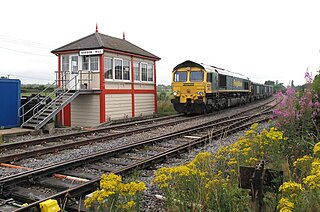
On a rail transport system, signalling control is the process by which control is exercised over train movements by way of railway signals and block systems to ensure that trains operate safely, over the correct route and to the proper timetable. Signalling control was originally exercised via a decentralised network of control points that were known by a variety of names including signal box, interlocking tower and signal cabin. Currently these decentralised systems are being consolidated into wide scale signalling centres or dispatch offices. Whatever the form, signalling control provides an interface between the human signal operator and the lineside signalling equipment. The technical apparatus used to control switches (points), signals and block systems is called interlocking.

In railway signalling, an interlocking is an arrangement of signal apparatus that prevents conflicting movements through an arrangement of tracks such as junctions or crossings. In North America, a set of signalling appliances and tracks interlocked together are sometimes collectively referred to as an interlocking plant or just as an interlocking. An interlocking system is designed so that it is impossible to display a signal to proceed unless the route to be used is proven safe.

Multibus is a computer bus standard used in industrial systems. It was developed by Intel Corporation and was adopted as the IEEE 796 bus.

Thirsk railway station is on the East Coast Main Line and serves the town of Thirsk, North Yorkshire, England. It is 210 miles 56 chains (339.1 km) down the line from London King's Cross and is situated between York to the south and Northallerton to the north. Its three-letter station code is THI.

Union Switch & Signal was an American company based in Pittsburgh, Pennsylvania, which focused on railway signaling equipment, systems and services. The company was acquired by Ansaldo STS in 1988, operating as a wholly-owned company until January 2009, when US&S was renamed "Ansaldo STS USA" to operate as a subsidiary of Ansaldo in the Americas and Asia.
Westinghouse Rail Systems Ltd was a British supplier of railway signalling and control equipment to the rail industry worldwide. Its head office was in Chippenham, Wiltshire, where it manufactured a variety of mechanical and electrical/electronic railway signalling equipment. It had six other UK offices in Croydon, York, Birmingham, Crawley, Swanley and Glasgow. It also had a number of overseas offices, particularly in the Far East, including Melbourne.
Australian railway signalling varies between the States of Australia, because the individual States are responsible for the railway systems within their own borders, with, historically, no need to co-ordinate between states except at the boundaries.

SimSig is a mixed donationware and commercial Windows-based train simulator of modern railway signalling systems in Great Britain, from the point of view of a railway signaller. Users have also had success running SimSig on Linux using Wine.
Metrol is the central control centre of the Melbourne suburban rail network. It controls signalling, passenger information, and emergency procedures. It is located at 595 Collins Street, Melbourne.

Mechanical railway signalling installations rely on lever frames for their operation to interlock the signals, track locks and points to allow the safe operation of trains in the area the signals control. Usually located in the signal box, the levers are operated either by the signalman or the pointsman.
Resonate Group Limited is a British software, technology and services company. Prior to September 2016, it was called DeltaRail Group Limited.

Doncaster PSB is a signalling centre on the East Coast Main Line (ECML) railway in the United Kingdom, principally covering the line from London to Edinburgh but also encompassing other lines diverging and converging to the ECML.

Solid State Interlocking (SSI) is the brand name of the first generation processor-based interlocking developed in the 1980s by British Rail's Research Division, GEC-General Signal and Westinghouse Signals Ltd in the UK.
WESTLOCK Interlocking is a Computer-based interlocking (CBI) product now sold and maintained by Siemens Mobility Limited, following their purchase of Westinghouse Rail Systems.
Thales Rail Signalling Solutions is a division of Thales Group that supplies transportation-based automation solutions for railways. Its operations are controlled from several locations:
Hitachi Rail STS SpA or Hitachi Rail STS is a transportation company owned by Hitachi with a global presence in the field of railway signalling and integrated transport systems for passenger traffic and freight operations. Hitachi Rail STS plans, designs, manufactures, installs and commissions signaling systems, components and technologies for the management and control of newly built or upgraded railways, transit and freight lines worldwide.

In the 2010s Network Rail modernised the Great Western Main Line, the South Wales Main Line, and other associated lines. The modernisation plans were announced at separate times but their implementation overlapped in the 2010s.
York Integrated Electronic Control Centre was a major signalling control centre on the East Coast Main Line railway between London and Edinburgh. The centre also contained the electrical control centre for the line and the LNE regional control office of Network Rail. Its responsibility for signalling across Yorkshire was transferred to York Rail Operating Centre in December 2018.

A rail operating centre (ROC) is a building that houses all signallers, signalling equipment, ancillaries and operators for a specific region or route on the United Kingdom's main rail network. The ROC supplants the work of several other signal boxes which have thus become redundant.

York Rail Operating Centre is a Rail operating centre (ROC) located at the south western end of York railway station in York, England. The site is one of twelve that will control all signalling across the mainland of the United Kingdom. It was opened in stages from 2014 onwards, with responsibility for signalling becoming active in January 2015. The York ROC accepted the role of its predecessor, the adjacent York Integrated Electronic Control Centre (IECC), in December 2018.











